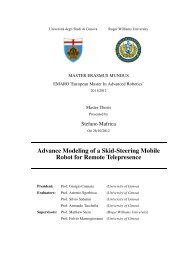Architecture Program Report Master of Architecture - Roger Williams ...
Architecture Program Report Master of Architecture - Roger Williams ...
Architecture Program Report Master of Architecture - Roger Williams ...
You also want an ePaper? Increase the reach of your titles
YUMPU automatically turns print PDFs into web optimized ePapers that Google loves.
History <strong>of</strong> the <strong>Architecture</strong> <strong>Program</strong><br />
Studies in <strong>Architecture</strong> began at <strong>Roger</strong> <strong>Williams</strong> College in 1976 as an area within the Division <strong>of</strong><br />
Engineering Technology, which awarded a four-year Bachelor <strong>of</strong> Science degree. The five-year Bachelor<br />
<strong>of</strong> <strong>Architecture</strong> program was <strong>of</strong>fered for the first time in Fall 1982. In Spring 1983, a new Director <strong>of</strong> the<br />
<strong>Architecture</strong> Division, Raj Saksena, AIA was hired, and the <strong>Architecture</strong> <strong>Program</strong> separated from<br />
Engineering to become its own division within <strong>Roger</strong> <strong>Williams</strong> College. The program was created to fulfill<br />
needs <strong>of</strong> the Northeast region that did not have an adequate number <strong>of</strong> undergraduate pr<strong>of</strong>essional<br />
degree program opportunities. The <strong>Roger</strong> <strong>Williams</strong> program was the first accredited Bachelor <strong>of</strong><br />
<strong>Architecture</strong> program in the United States to be created within a small, private liberal arts college.<br />
Following a team visit in 1984 and follow-up visit in 1985, the Bachelor <strong>of</strong> <strong>Architecture</strong> program received<br />
its initial accreditation in June, 1985.<br />
In 1984, <strong>Roger</strong> <strong>Williams</strong> College, supported by the National Endowment for the Arts, sponsored a<br />
national design competition for the design <strong>of</strong> a new <strong>Architecture</strong> building, won by Kite Palmer Architects,<br />
Providence. The award-winning design was built and the new building occupied in 1987. In 1990, the<br />
<strong>Architecture</strong> Division became the School <strong>of</strong> <strong>Architecture</strong>, housing the five-year Bachelor <strong>of</strong> <strong>Architecture</strong><br />
program and the four-year Bachelor <strong>of</strong> Science in Historic Preservation programs. The Director, Raj<br />
Saksena became the Dean <strong>of</strong> the School <strong>of</strong> <strong>Architecture</strong>, and was recognized as a Fellow <strong>of</strong> the<br />
American Institute <strong>of</strong> Architects in 1993, for service to the pr<strong>of</strong>ession and for education. Study Abroad<br />
programs in <strong>Architecture</strong> began in 1990 in Greece and Turkey, followed by alternate year programs in<br />
Prague/Brno/Vienna in 1994/96/98/00, and 2002; England in Fall or Spring semesters in conjunction with<br />
Historic Preservation majors from1995-1999.<br />
In 1997, the School <strong>of</strong> <strong>Architecture</strong> began a strategic planning process under new leadership, with<br />
Stephen White, AIA being appointed dean. This process led to the 1999 reorganization into the School <strong>of</strong><br />
<strong>Architecture</strong>, Art and Historic Preservation, with expanded undergraduate pr<strong>of</strong>essional and liberal arts<br />
programs in <strong>Architecture</strong> (Bachelor <strong>of</strong> <strong>Architecture</strong>, B.S. in <strong>Architecture</strong>), Art (B.A. in Visual Arts Studies),<br />
Historic Preservation (B.A. in Heritage Resource Studies, B.S. in Historic Preservation), and a new B.A. in<br />
Art and Architectural History, and the school’s faculty participating in delivering the University’s Core<br />
Curriculum. In 1999-2000, in concert with the nationwide review then underway <strong>of</strong> pr<strong>of</strong>essional degree<br />
program structure and nomenclature emerging from the 1991 Five Presidents Accord (ACSA, AIA, AIAS,<br />
NAAB, NCARB), and The Boyer <strong>Report</strong>, and in accord with its own advance the School <strong>of</strong> <strong>Architecture</strong>,<br />
Art and Historic Preservation began a process to:<br />
revise its 5-year, 172 credit Bachelor <strong>of</strong> <strong>Architecture</strong> program to introduce greater curricular<br />
flexibility for students, and increased linkages simultaneously with the University, pr<strong>of</strong>ession, and<br />
community<br />
introduce a 5-1/2-6 year 186 credit B.S. / <strong>Master</strong> <strong>of</strong> <strong>Architecture</strong> dual degree as the pr<strong>of</strong>essional<br />
program that would replace the B.Arch. as the School’s NAAB accredited pr<strong>of</strong>essional program.<br />
In June 2000, NAAB granted a full five-year term <strong>of</strong> Accreditation to the 5-year, 172 credit Bachelor <strong>of</strong><br />
<strong>Architecture</strong> program, and Candidacy status to the 5-1/2-6 year, 186 credit B.S. in <strong>Architecture</strong> /<strong>Master</strong> <strong>of</strong><br />
<strong>Architecture</strong> dual degree program sequence being phased in. The term was subsequently extended to six<br />
years, in keeping with NAAB’s revised, extended accreditation cycle, as was the Candidacy term <strong>of</strong> the<br />
B.S./<strong>Master</strong> <strong>of</strong> <strong>Architecture</strong> program. <strong>Roger</strong> <strong>Williams</strong> sought to introduce the <strong>Master</strong> <strong>of</strong> <strong>Architecture</strong> to<br />
replace the Bachelor <strong>of</strong> <strong>Architecture</strong> program in order to provide:

















